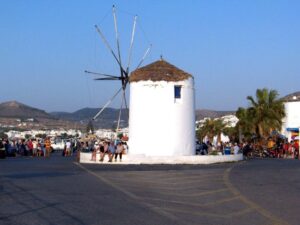Geographical & Historical Outline of Paros
Paros is an oval in shape island, its center dominated by Mount Profitis Elias.
It lies close to the islands of Antiparos, Naxos and Sifnos and has an area of 165 square kilometers.
The island has plentiful water and vegetation, including the vines that yield the fine local wine, fruit trees, olives etc.
Geographical & Historical Outline of Paros
On the small island of Saliangos, in the narrows between Paros and Antiparos, the archaeologist’s spade has revealed the remains of a Neolithic civilization going back to 4300 – 3700 BC.
The Saliangos civilization is a forerunner of the Cycladic.
During the Early Cycladic period (3200-2800BC), Paros and its neighbor Antiparos evolved an important civilization.
During the Minoan period, it was conquered by the Cretans and was a harbor of great strategic importance.
At the beginning of the first millennium BC, Arkadians settled on the island under their leader Paros, from whom the present name of the island is derived.
At this period Paros already had a large naval force, farming was developed, and the trade in marble was at its height.
During the Classical period, sculpture flourished on the island.
At the time of the Frankish occupation, and later under the Turks, the island suffered from pirate raids, but the Frankish period was nevertheless one of growth and prosperity.
The marble quarries again became as active as they had been in ancient times, and Frankish boats carried the stone to the major cities in Italy.
Paros played an active role during the Greek Revolution of 1821.


